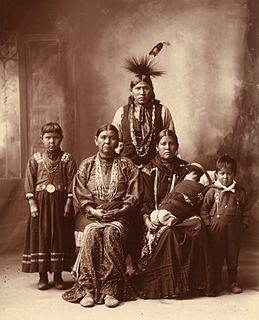Related Research Articles

Adoption is a process whereby a person assumes the parenting of another, usually a child, from that person's biological or legal parent or parents. Legal adoptions permanently transfer all rights and responsibilities, along with filiation, from the biological parents to the adoptive parents.
When a person assumes the family name of their spouse, in some countries that name replaces the person's previous surname, which in the case of the wife is called the maiden name, whereas a married name is a family name or surname adopted by a person upon marriage.

A wife is a female in a marital relationship. A woman who has separated from her partner continues to be a wife until the marriage is legally dissolved with a divorce judgement. On the death of her partner, a wife is referred to as a widow. The rights and obligations of a wife in relation to her partner and her status in the community and in law vary between cultures and have varied over time.
Common-law marriage, also known as non-ceremonial marriage, sui iuris marriage, informal marriage, or marriage by habit and repute, is a legal framework where a couple may be considered married without having formally registered their relation as a civil or religious marriage.
A stepfamily is a family where at least one parent has children that are not biologically related to their spouse. Either parent, or both, may have children from previous relationships or marriages. Two known classifications for stepfamilies include "simple" stepfamilies, where only one member of the family's couple has a prior child or children and the couple does not have any children together, and "complex" or "blended" families, where both members of the couple have at least one pre-existing child.
A single parent is a person who lives with a child or children and who does not have a spouse or live-in partner to assist in the upbringing or support of the child. Reasons for becoming a single parent include divorce, break-up, abandonment, domestic violence, rape, death of the other parent, childbirth by a single person or single-person adoption. A single parent family is a family with children that is headed by a single parent.
A conjugal family is a nuclear family that may consist of a married couple and their children or a couple who are unmarried or underage. Conjugal means there is a marriage relationship. The family relationship is principally focused inward and ties to extended kin are voluntary and based on emotional bonds, rather than strict duties and obligations. The spouses and their children are considered to be of prime importance, and other more distant relatives less important. The marriage bond is important and stressed.
The main family law of Japan is Part IV of Civil Code. The Family Register Act contain provisions relating to the family register and notifications to the public office.
Childlessness is the state of not having children. Childlessness may have personal, social or political significance.
The China Center of Adoption Affairs (CCAA) was established on June 24, 1996 by China's Ministry of Civil Affairs. The CCAA is responsible for the welfare of children in the care of Child Welfare Institutes (orphanages), domestic adoption, and international adoption.

Family is a group of people related either by consanguinity or affinity. The purpose of the family is to maintain the well-being of its members and of society. Ideally, families offer predictability, structure, and safety as members mature and learn to participate in the community. In most human societies, the family is the primary locus of attachment, nurturance, and socialization.
Common-law relationships in Manitoba are government-sanctioned relationships available to both same-sex and different-sex unmarried couples in the Canadian province of Manitoba. While not as extensive as the rights and benefits of marriage, these relationships provide some important benefits to unmarried couples. Registration is voluntary; many of the laws apply automatically to any couple in the province after living together for several years.

Since 2003, adult interdependent relationships have been available to both same-sex and opposite-sex couples in the Canadian province of Alberta, imposing some but not all of the obligations of marriage and providing some but not all the rights and benefits thereof.

The traditional family structure in the United States is considered a family support system involving two married individuals providing care and stability for their biological offspring. However, this two-parent, heterosexual, nuclear family has become less prevalent, and nontraditional family forms have become more common. The family is created at birth and establishes ties across generations. Those generations, the extended family of aunts and uncles, grandparents, and cousins, can hold significant emotional and economic roles for the nuclear family.
Until 2017, laws related to LGBT+ couples adopting children varied by state. Some states granted full adoption rights to same-sex couples, while others banned same-sex adoption or only allowed one partner in a same-sex relationship to adopt the biological child of the other. Despite these rulings, LGBT+ people and same-sex couples still face discrimination when attempting to foster children.

Adoption in the Philippines is a process of granting social, emotional and legal family and kinship membership to an individual from the Philippines, usually a child. It involves a transfer of parental rights and obligations and provides family membership. The Department of Social Welfare and Development (DSWD) defines adoption as a "socio-legal process of giving a permanent family to a child whose parents have voluntarily or involuntarily given up their parental rights."
A stepchild is the offspring of one's spouse, but not one's own offspring, either biologically or through adoption.
The second-parent adoption or co-parent adoption is a process by which a partner, who is not biologically related to the child, can adopt their partner's biological or adoptive child without terminating the first legal parent's rights. This process is of interest to many couples, as legal parenthood allows the parent's partner to do things such as: make medical decisions, claim dependency, or gain custody in the event of the death of the biological parent.
Same-sex adult adoption involves adult adoption—the adoption of one adult by another—of a partner in order to benefit in some way, such as to create family relationships, to ensure inheritance rights and to keep collateral relatives from contesting the estate plan of the adopted adult. It was most prevalent from the 1970s and 1980s to early 2000s, as during that time, many countries had not legalised same-sex marriage. It was mostly used due to same-sex marriage not being available in some countries, to create a family unit, get property and inheritance rights, securing insurance benefits and allowing recovery in tort. Same-sex adult adoption has evolved during the years, becoming less prevalent in countries where same-sex marriage is legal. It is not to be confused with LGBT adoption, wherein another party is adopted by a couple.
References
- 1 2 "Statistics Canada – Census dictionary: "Census family"" . Retrieved 2015-03-30.
- ↑ "Info please, US Census Bureau median household income" . Retrieved 2006-06-30.